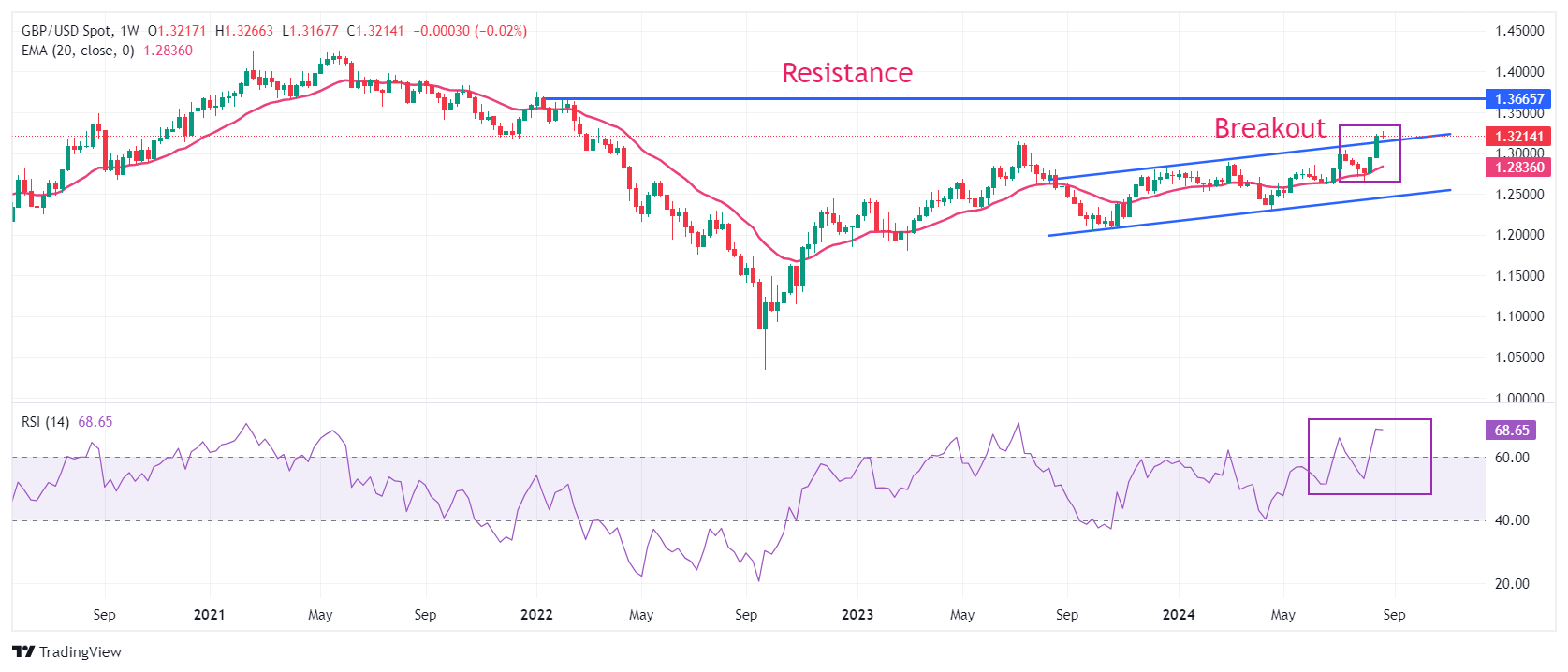Pound Sterling rises from 1.3200 with US PCE inflation on horizon

- The Pound Sterling moves higher back above 1.3200 against the US Dollar following Wednesday’s pullback.
- Traders focus on US core PCE inflation data for July, which can influence market speculation about the Fed’s rate cut size.
- Investors see the BoE delivering one more interest rate cut this year.
The Pound Sterling (GBP) rebounds from the key support of 1.3200 against the US Dollar (USD) in Thursday’s European session. The GBP/USD pair rises as the US Dollar (USD) edges lower after bouncing back strongly on Wednesday. The US Dollar Index (DXY), which tracks the Greenback’s value against six major currencies, faces pressure in an attempt to extend its recovery above the immediate resistance of 101.20.
The Greenback is expected to struggle to hold to its recent rebound as the Federal Reserve (Fed) is almost certain to begin reducing interest rates from the September meeting. While traders are split over whether the Fed will start the policy-easing spell with a 25 or a 50-basis-points (bps) cut, the rate reduction is fully priced in.
Firm speculation for the Fed to start cutting interest rates from September is driven by Fed Chair Jerome Powell’s dovish commentary on interest rates at the Jackson Hole (JH) Symposium held last week. Powell said that “the time has come for policy to adjust,” highlighting that the US central bank is now more worried about downside risks to the labor market as inflation looks on track to return to the desired rate of 2%.
Meanwhile, investors await the United States (US) Personal Consumption Expenditure Price Index (PCE) report for July, which will be published on Friday. The PCE report is expected to show that year-on-year core inflation rose at a faster pace of 2.7% from 2.6% in June, with monthly figures growing steadily by 0.2%. The inflation data could significantly influence market speculation for the Federal Reserve’s (Fed) September monetary policy decision.
In Thursday’s session the UK economic calendar is empty, but investors will focus on plenty of US data. One of the key points is the second estimate of the Q2 Gross Domestic Product (GDP) data, which will be published at 12:30 GMT. Economists expect that the data won’t be revised, confirming that the US economy expanded by 2.8% on an annualized basis. The GDP data is unlikely to impact the US Dollar significantly unless there is a significant revision. Apart from that, the weekly US Jobless Claims numbers are also due, which have the potential to move markets in case of a substantial increase.
Daily digest market movers: Pound Sterling outperforms its major peers
- The Pound Sterling performs strongly against its major peers, except Asia-Pacific currencies, in European trading hours. The British currency remains firm as the Bank of England (BoE) is expected to follow a gradual policy-easing cycle, given that the victory over the United Kingdom (UK) inflation isn’t certain.
- BoE Governor Andrew Bailey signaled in his speech at the JH Symposium on Friday that the second-round effects of inflationary pressures would be smaller than expected, but also said that the UK central bank should not rush for more interest rate cuts, Reuters reported. The BoE would “be careful not to cut interest rates too quickly or by too much,” Bailey said.
- BoE officials have been reluctant to offer a preset rate-cut path as inflation in the service sector has remained higher due to wage pressures. Going forward, the Pound Sterling will be guided by market expectations for BoE rate cuts for the remainder of the year amid the absence of top-tier economic data this week. Markets expect the BoE to cut its borrowing rates one more time this year.
British Pound PRICE Today
The table below shows the percentage change of British Pound (GBP) against listed major currencies today. British Pound was the strongest against the Euro.
| GBP | EUR | USD | JPY | CAD | AUD | NZD | CHF | |
|---|---|---|---|---|---|---|---|---|
| GBP | 0.27% | 0.10% | 0.15% | -0.02% | -0.19% | -0.39% | 0.25% | |
| EUR | -0.27% | -0.17% | -0.11% | -0.28% | -0.45% | -0.66% | -0.06% | |
| USD | -0.10% | 0.17% | 0.03% | -0.12% | -0.30% | -0.51% | 0.09% | |
| JPY | -0.15% | 0.11% | -0.03% | -0.15% | -0.34% | -0.58% | 0.08% | |
| CAD | 0.02% | 0.28% | 0.12% | 0.15% | -0.17% | -0.39% | 0.25% | |
| AUD | 0.19% | 0.45% | 0.30% | 0.34% | 0.17% | -0.19% | 0.44% | |
| NZD | 0.39% | 0.66% | 0.51% | 0.58% | 0.39% | 0.19% | 0.63% | |
| CHF | -0.25% | 0.06% | -0.09% | -0.08% | -0.25% | -0.44% | -0.63% |
The heat map shows percentage changes of major currencies against each other. The base currency is picked from the left column, while the quote currency is picked from the top row. For example, if you pick the British Pound from the left column and move along the horizontal line to the US Dollar, the percentage change displayed in the box will represent GBP (base)/USD (quote).
Technical Analysis: Pound Sterling finds support near 1.3200
The Pound Sterling rebounds after a mild corrective move to near the round-level support of 1.3200. against the US Dollar. The near-term appeal of the GBP/USD pair remains firm as it holds the breakout of the Rising Channel chart formation on the weekly time frame. If bullish momentum resumes, the Cable is expected to extend its upside towards the psychological resistance of 1.3500 and the February 4, 2022, high of 1.3640 after breaking above a fresh two-and-a-half-year high of 1.3266 against the US Dollar.
The upward-sloping 20-week Exponential Moving Average (EMA) near 1.3000 suggests a strong upside trend.
The 14-period Relative Strength Index (RSI) oscillates in the bullish range of 60.00-80.00, suggesting a strong upside momentum. Still, it has reached overbought levels at around 70.00, increasing the chances of a corrective pullback. On the downside, the psychological level of 1.3000 will be the crucial support for the Pound Sterling bulls.
Pound Sterling FAQs
The Pound Sterling (GBP) is the oldest currency in the world (886 AD) and the official currency of the United Kingdom. It is the fourth most traded unit for foreign exchange (FX) in the world, accounting for 12% of all transactions, averaging $630 billion a day, according to 2022 data. Its key trading pairs are GBP/USD, aka ‘Cable’, which accounts for 11% of FX, GBP/JPY, or the ‘Dragon’ as it is known by traders (3%), and EUR/GBP (2%). The Pound Sterling is issued by the Bank of England (BoE).
The single most important factor influencing the value of the Pound Sterling is monetary policy decided by the Bank of England. The BoE bases its decisions on whether it has achieved its primary goal of “price stability” – a steady inflation rate of around 2%. Its primary tool for achieving this is the adjustment of interest rates. When inflation is too high, the BoE will try to rein it in by raising interest rates, making it more expensive for people and businesses to access credit. This is generally positive for GBP, as higher interest rates make the UK a more attractive place for global investors to park their money. When inflation falls too low it is a sign economic growth is slowing. In this scenario, the BoE will consider lowering interest rates to cheapen credit so businesses will borrow more to invest in growth-generating projects.
Data releases gauge the health of the economy and can impact the value of the Pound Sterling. Indicators such as GDP, Manufacturing and Services PMIs, and employment can all influence the direction of the GBP. A strong economy is good for Sterling. Not only does it attract more foreign investment but it may encourage the BoE to put up interest rates, which will directly strengthen GBP. Otherwise, if economic data is weak, the Pound Sterling is likely to fall.
Another significant data release for the Pound Sterling is the Trade Balance. This indicator measures the difference between what a country earns from its exports and what it spends on imports over a given period. If a country produces highly sought-after exports, its currency will benefit purely from the extra demand created from foreign buyers seeking to purchase these goods. Therefore, a positive net Trade Balance strengthens a currency and vice versa for a negative balance.
Source link






